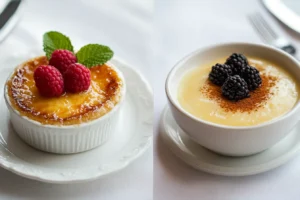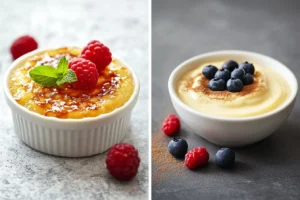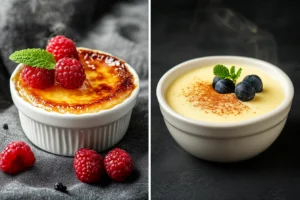Crème brûlée and custard are both beloved desserts, celebrated for their creamy textures and versatility. However, while they may share some ingredients and techniques, the key differences set them apart as distinct culinary creations. This guide explores everything you need to know about these two desserts, including their origins, core ingredients, and preparation methods.
What is Crème Brûlée?
Definition
Crème brûlée is a classic French dessert consisting of a rich custard base topped with a layer of caramelized sugar. Its name translates to “burnt cream,” referring to the signature torched sugar crust.
Origins
Dating back to the 17th century, crème brûlée has long been a symbol of luxury in French cuisine and remains a staple in fine dining establishments worldwide.
Key Characteristics
The dessert is renowned for its creamy texture beneath a crisp, caramelized sugar topping, which provides a satisfying contrast.
What is Custard?
Definition
Custard is a broad category of desserts made by combining eggs, milk, and sugar, often cooked until thickened. Unlike crème brûlée, it does not always feature a caramelized topping.
Variations
Custard can be prepared in numerous forms, from baked varieties like flan to stovetop versions such as pastry cream or pudding.
Popularity in Desserts
Custard serves as a versatile base for countless desserts, including trifles, tarts, and ice cream.
The Core Ingredients of Each
Eggs, Milk, Cream, and Sugar
Both crème brûlée and custard share similar foundational ingredients, but the ratios and techniques make all the difference.
The Role of Eggs in Both Recipes
- Egg Ratio: Crème brûlée typically uses a higher proportion of egg yolks, contributing to its rich and silky texture. In contrast, custard often includes whole eggs for a firmer set.
- Texture: The egg-to-liquid ratio directly influences the consistency, with crème brûlée being creamier and custard firmer.
- Setting Process: Both desserts rely on gentle heat to coagulate the eggs, creating a smooth structure.
Differences in Cream Usage
- Types of Cream: Crème brûlée primarily uses heavy cream, whereas custard often incorporates milk or a combination of milk and cream.
- Fat Content: The higher fat content in heavy cream gives crème brûlée its luxurious mouthfeel, while custard’s lighter profile comes from using milk.
- Flavor Impact: The richness of cream enhances crème brûlée’s flavor, while custard’s simplicity allows added flavorings to shine.

Cooking Techniques Compared
Baking vs. Stovetop Methods
- Crème Brûlée: Always baked in a water bath to ensure even cooking and a delicate texture.
- Custard: Can be baked or cooked on the stovetop, depending on the recipe (e.g., flan vs. pastry cream).
Water Baths
The water bath prevents overheating, which is crucial for both crème brûlée and baked custards to avoid curdling.
Temperature Control
Precise heat is key in both desserts, as overcooking can lead to a grainy texture.
The Caramelized Topping of Crème Brûlée
- Tools Needed: A culinary torch is ideal for creating a crisp, caramelized crust. Alternatively, a broiler can be used.
- Torch vs. Oven: While a torch provides precision, an oven broiler is a practical substitute.
- Achieving the Perfect Crust: Use an even layer of sugar and caramelize it just before serving for the best results.
Textural Differences Between the Two
- Crème Brûlée: Defined by its creamy custard and crisp sugar topping.
- Custard: Offers a uniformly smooth texture without the contrasting crunch.
Flavor Variations and Additions
Vanilla, Chocolate, and Fruit Infusions
Both desserts are highly versatile, with endless opportunities for flavor customization:
- Vanilla: The classic choice, using vanilla bean or extract.
- Chocolate: For a rich, decadent twist, add melted chocolate.
- Fruit Infusions: Infuse milk or cream with citrus zest, berries, or herbs like lavender.
How Flavoring Techniques Vary
- Infusing Milk or Cream: Heat milk or cream with flavoring agents (e.g., vanilla pods or citrus zest) before combining with other ingredients.
- Adding Extracts: Vanilla or almond extracts can be stirred into the custard mixture just before cooking.
- Timing of Additions: Proper timing is crucial—add flavorings early for infusion or after cooking for a more pronounced taste.
By understanding the differences between crème brûlée and custard, you can appreciate the unique qualities of each dessert. Whether you’re craving the crisp caramelized topping of crème brûlée or the simplicity of a classic custard, both are sure to delight your taste buds.
Presentation and Serving Styles
How you present and serve crème brûlée and custard can elevate the dining experience and make these desserts even more memorable.
Traditional Ramekins
- Crème Brûlée: Typically served in shallow, wide ramekins to maximize the surface area for caramelization.
- Custard: Served in deeper ramekins or dishes, allowing for a thicker layer of creamy dessert.
Garnishes
- Crème Brûlée: A sprig of mint, fresh berries, or a light dusting of powdered sugar enhances the visual appeal.
- Custard: Top with whipped cream, caramel sauce, or a sprinkle of cinnamon for added flavor.
Pairing Ideas
- Crème Brûlée: Pairs beautifully with a glass of dessert wine or espresso.
- Custard: Complements a variety of sides, from fruit compote to shortbread cookies.

Common Mistakes to Avoid in Each Recipe
Overcooking
- Overcooked crème brûlée becomes grainy, while custard may crack. Use a water bath and monitor temperatures carefully.
Improper Caramelization
- Using too much sugar or holding the torch too close can burn crème brûlée’s crust. Stick to an even, thin layer of sugar.
Curdling Issues
- Rapidly adding hot cream to eggs can scramble them. Always temper the eggs slowly by whisking in the warm liquid gradually.
Frequently Asked Questions
1. Is crème brûlée just a type of custard?
Yes, crème brûlée is a specific type of custard distinguished by its caramelized sugar topping.
2. Can I make custard without a water bath?
Some stovetop custards, like pudding or pastry cream, don’t require a water bath, but baked custards like flan do for even cooking.
3. Which dessert is easier to make?
Custard is generally simpler, while crème brûlée requires extra steps like caramelizing the sugar.
4. Do both desserts require heavy cream?
No, custard often uses milk, while crème brûlée relies on heavy cream for its rich texture.
5. Can I substitute ingredients?
Yes, you can use alternative milks or cream, but results may vary in flavor and texture.
6. How do I store leftovers?
Both desserts can be refrigerated for up to three days, but caramelized crème brûlée should be consumed immediately after caramelization.

Nutritional Differences
Calorie Comparison
- Crème Brûlée: Typically higher in calories due to heavy cream and the sugar topping.
- Custard: Generally lighter, especially if made with milk instead of cream.
Macronutrients
- Crème Brûlée: Higher in fat and sugar.
- Custard: Offers a more balanced macronutrient profile, depending on the recipe.
Portion Sizes
- Keep servings small to manage calorie intake, especially for richer desserts like crème brûlée.
Which Dessert Suits Your Occasion?
Casual Dining
Custard’s simplicity makes it an excellent choice for everyday desserts or casual gatherings.
Special Events
Crème brûlée’s elegance and dramatic caramelized topping make it perfect for dinner parties or romantic dinners.
Seasonal Preferences
- Crème Brûlée: Enjoyable year-round, with seasonal flavors like pumpkin in the fall.
- Custard: Lighter options like fruit custards are refreshing in the summer.
What is Custard?
Definition
Custard is a versatile dessert made by blending eggs, milk, and sugar. Unlike crème brûlée, custard can be served in various forms, such as baked, stovetop, or frozen.
Variations
From simple puddings to elaborate flans, custard adapts to countless recipes, making it a staple in dessert menus worldwide.
Popularity in Desserts
Custard serves as the foundation for many dishes, including trifles, tarts, and pastries. Learn more about custard’s role in diverse recipes with our step-by-step guide to classic desserts.
The Core Ingredients of Each
Eggs, Milk, Cream, and Sugar
Both desserts rely on these essential ingredients, but their ratios and preparation methods create distinct differences.
Differences in Cream Usage
- Crème Brûlée: Primarily uses heavy cream for a rich texture.
- Custard: Often incorporates milk or a milk-cream blend for a lighter consistency.
For a deeper dive into ingredient roles, check out our best cream for dessert recipes.
Cooking Techniques Compared
Baking vs. Stovetop Methods
- Crème Brûlée: Baked in a water bath to ensure even cooking and a silky texture.
- Custard: Can be prepared on the stovetop or baked, depending on the recipe.
Temperature Control
Precise heat management is crucial for both desserts to prevent curdling or overcooking.
Caramelized Topping for Crème Brûlée
Achieving a perfect sugar crust requires either a culinary torch or an oven broiler. Learn how to master this step in our ultimate crème brûlée guide.
Conclusion
Crème brûlée and custard share a common foundation but differ significantly in their preparation, texture, and presentation. Crème brûlée’s luxurious caramelized topping makes it ideal for special occasions, while custard’s versatility and simplicity are perfect for everyday enjoyment. Whichever you choose, both desserts promise to satisfy your sweet tooth. Try your hand at both recipes and discover which one becomes your favorite!
Chicken Cooking Temperature Guide
Equipment
- Meat Thermometer
- Oven
- Grill
Ingredients
Chicken Cuts
- 2 lbs chicken (breasts, thighs, drumsticks, or wings)
- 2 tbsp olive oil or melted butter
- 1 tsp salt
- 1/2 tsp black pepper
- 1 tsp garlic powder
- 1 tsp paprika optional, for color
- 1/2 tsp dried thyme or rosemary for extra flavor
Instructions
- Remove chicken from the fridge 15-20 minutes before cooking to bring it to room temperature.
- Pat dry with paper towels for a better sear and even cooking.
- In a bowl, mix olive oil, salt, black pepper, garlic powder, paprika, and thyme.
- Coat the chicken evenly with the seasoning mix.
- Cook using your preferred method:
- Baking: Preheat oven to 400°F (200°C). Bake chicken breast for 20-25 minutes, thighs for 35-40 minutes, or until the internal temp reaches 165°F (75°C).
- Grilling: Grill over medium-high heat for 6-8 minutes per side, ensuring the internal temp reaches 165°F (75°C).
- Pan-Searing: Heat a pan over medium-high heat, cook chicken for 4-5 minutes per side, then finish in the oven if needed.
- Air Frying: Set air fryer to 375°F (190°C). Cook for 15-18 minutes, flipping halfway through.
- Slow Cooking: Set to low heat for 4-6 hours or until the chicken reaches 165°F (75°C).
- Insert a meat thermometer into the thickest part of the chicken. Ensure it reads at least 165°F (75°C) for white meat and 175-185°F (79-85°C) for dark meat.
- Let chicken rest for 5-10 minutes before cutting.
- Serve with your favorite sides like roasted veggies, mashed potatoes, or rice.

